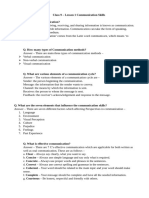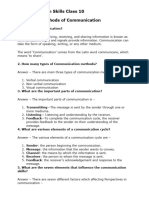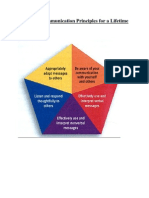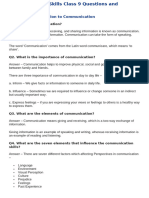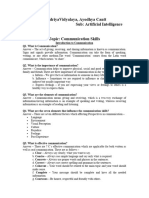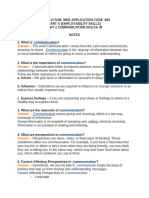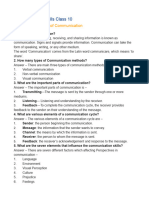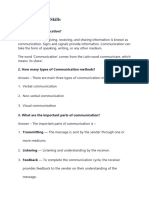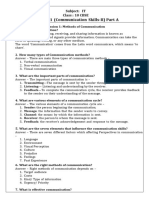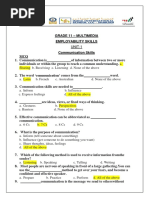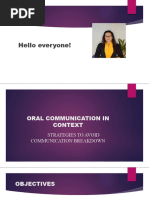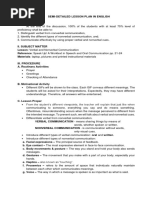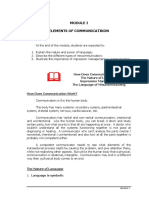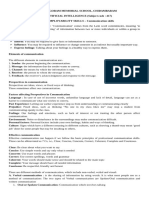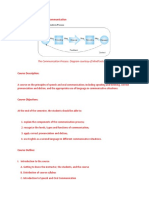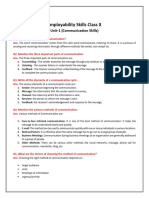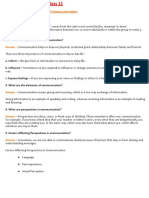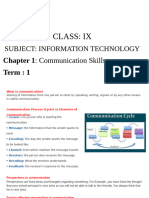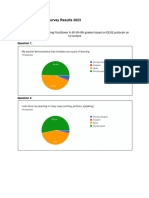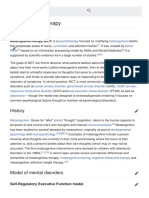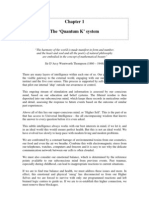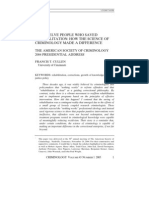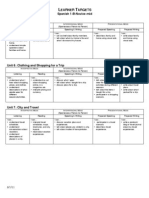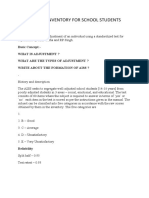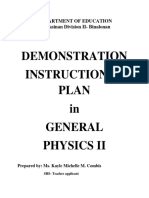1727317489095.Unit 1 Communication Skills Class 9 Questions and Answers
1727317489095.Unit 1 Communication Skills Class 9 Questions and Answers
Uploaded by
Vishant PatelCopyright:
Available Formats
1727317489095.Unit 1 Communication Skills Class 9 Questions and Answers
1727317489095.Unit 1 Communication Skills Class 9 Questions and Answers
Uploaded by
Vishant PatelCopyright
Available Formats
Share this document
Did you find this document useful?
Is this content inappropriate?
Copyright:
Available Formats
1727317489095.Unit 1 Communication Skills Class 9 Questions and Answers
1727317489095.Unit 1 Communication Skills Class 9 Questions and Answers
Uploaded by
Vishant PatelCopyright:
Available Formats
Communication Skills Class 9 Questions and
Answers
Session 1: Introduction to Communication
Q1. What is Communication?
Answer – The act of giving, receiving, and sharing information is known as communication.
Signs and signals provide information. Communication can take the form of speaking,
writing, or any other medium.
The word ‘Communication’ comes from the Latin word communicare, which means ‘to
share’.
Q2. What is the importance of communication?
Answer – Communication helps to improve physical, social and good relationships
between family and friends.
There are three importance of communication in day to day life –
a. Inform – We give facts or information to someone in daisy life.
b. Influence – Sometimes we are required to influence or change someone in an indirect
but usually important way.
c. Express feelings – if you are expressing your views or feelings to others is a healthy way
to express them.
Q3. What are the elements of communication?
Answer – Communication means giving and receiving, which is a two-way exchange of
information.
Giving information is an example of speaking and writing, whereas receiving information is
an example of reading and listening.
Q4. What are the seven elements that influence the communication
skills?
Answer – There are seven different factors which affecting Perspectives in communication:
Language
Environment
Visual Perception
Culture
Prejudice
Feelings
Past Experience
Q5. What is effective communication?
Answer – There are 7 C’s effective communication which are applicable for both written as
well as oral communication. These are as follows –
a. Clear – Always say clearly, what you want to say.
b. Concise – Always use simple language and say only what is required.
c. Concrete – Always use proper words and phrases in the sentences.
d. Correct – Always use correct spelling and grammar in the sentences.
e. Coherent – Your word should be related to the main topic and your word should make
sense.
f. Complete – Your message should be complete and have all the needed information.
g. Courteous – Be honest, respectful and friendly with others.
Q6. How many types of Communication methods?
Answer – There are main three types of communication methods –
a. Verbal communication
b. Non-verbal communication
c. Visual communication
Session 2: Verbal Communication
Q7. What is verbal communication? Advantages and disadvantages of
verbal communication.
Answer – Communication is a two-way method for exchanging information, thoughts,
ideas, and feelings. In verbal communication we can share ideas or thoughts in the form of
sound and word, it is also known as face – to – face communication.
Advantages of Verbal communication
a. Time Saving – We can express our thoughts easily and quickly and it is an easier form
of communication.
b. Quick Feedback – We can get a quick response from the listener.
Disadvantages of verbal communication
a. Cultural Difference – The cultural difference is the main disadvantage of verbal
communication
b. Language barriers – Difficult to share thoughts or ideas in different languages.
Q8. What is public speaking?
Answer – Speaking face – to – face to a live audience or in front of a large group is known
as public speaking, you can use the 3Ps method to get over your fears, and become a
confident speaker.
The 3Ps method is –
a. Prepare
b. Practice
c. Perform
Q9. Write down the different types of verbal communication. Give an
example for each type.
Answer – Verbal communication can be divided into two categories.
a. Oral or Spoken communication – Oral Communication involves Face-to-face
communication, Teaching in classroom or talking on the phone is an example of oral or
spoken communication.
b. Written Communication – Written Communication involves written or typed words.
Banners, Articles, Notes, Writing letters, email, and Short Messaging Services are
examples of written communication.
Session 3: Non-Verbal Communication
Q10. What is non-verbal communication?
Answer – Without using word if you are sending some information to others is known as
non- verbal communication, Some of the non – verbal communication is –
Eye contact
Gestures
Expressions
Posture
Space
Para Language
Touch
Q11. What role does non-verbal communication play?
Answer – In our daily life it is observed that most of the communication is done using body
movements and voice control.
Importance of non-verbal communication
a. In the non-verbal communication you can make your message stronger as compared to
written communication.
b. Helps overcome cultural barriers.
c. With the right gestures while speaking makes our message more effective
d. Using the right gestures and postures helps us to be professional at work.
e. The message is delivered and communicated more effectively than verbal
communication.
f. In the time of public speech you can understand the audience’s reaction easily and
adjust our behavior or communication accordingly.
Q12. Type of non-verbal communication?
Answer – We communicate non-verbally in many ways –
a. Facial expressions – The movement and changes of the face are the facial
expressions. Many times facial expressions show the feelings of a person. For example,
expressing your thoughts using a smile, when we are happy, or when we are sad.
b. Posture – Postures means body of the positions, postures shows how confident you are
and your emotional feelings. For example, straight body posture means confidence.
c. Gestures or Body language – Gestures means with the help of hands or head if you
are sharing any idea or meaning. for example pointing, waving and using our hands when
speaking.
d. Touch – Some time we communicate using touch we also share messages to others,
for example hand shaking and patting on the back.
e. Space – When the two people are communicating and you will find some space
between these two people depending on closeness or intimacy between them.
f. Eye contact – Maintaining eye contact is very important when you are talking about
interest, whereas, looking at any other side can make the other person feel ignored.
g. Paralanguage – Tone of our voice, speed and volume that makes a difference in the
meaning is a paralanguage.
Q13. What is visual communication?
Answer – In daily life we are using visual communication. Sometimes we are getting
messages from images or pictures. The main advantage of visual communication is that
you do not need to know any particular language.
Example of visual communication
a. Sign for ladies and gents toilet
b. Traffic symbol
c. Sign for flammable substance
Session 4: Writing Skills: Parts of Speech
Q14. What are Written Skills?
Answer – If you are sending any message or instruction through writing is known as written
communication. Written communication is important because it communicates the
message with clarity and ease.
How to improve writing skills
a. Improve your Vocabulary
b. Capitalization Rules
c. Punctuation
d. Basic parts of speech
Q15. What are the basic parts of speech in the English Language?
Answer – There are eight basic parts of speech in the English language. These are none,
pronoun, verb, adjective, adverb, preposition, conjunction and interjection.
a. Noun – Nouns is the name of a person, place, animal or thing. This is also called
‘naming words.
b. Pronoun – A pronoun is used in place of a noun.
c. Adjectives – Adjectives are words that describe other words.
d. Verbs – Verbs are words that show action.
e. Adverbs – Adverbs are words that add meaning to verbs, adjectives, or other adverbs.
f. Preposition – A preposition is a word palace before a noun or pronoun.
g. Conjunction – A conjunction is a word that connects two words, phrases, or clauses.
h. Interjection – A word used to communicate emotion is called an interjection.
Session 5: Writing Skills: Sentences
Q16. What are the various parts of the Sentence?
Answer -A subject and a verb make up a sentence. There is an object in some of the
sentences. The subject is generally a noun, which is a term that refers to a person or thing
who performs a specific activity.
The verb comes after the subject and indicates that something is being done. An object,
which usually comes after the verb, receives the action.
There are three different types of parts of sentences –
Subject
Verb
Object
Q17. How many types of objects are there in the English language?
Answer – Object normally comes after the verb phrase. The presence or absence of an
object is determined by the verb’s meaning. There are two types of objects in English
language
a. Direct – Direct objects are the results of action, A direct object answers the questions
‘what’ or ‘whom’. Ramesh collected honey all day. hear honey becomes the direct object.
b. Indirect – An indirect object answers the questions ‘to whom’, ‘for whom’, ‘to what’ and
‘for what’. for example, in the sentence “Imran gave a gift to his mother.” The verb is “gave”
and in the sentence there are two objects “gift” and “mother”.
Q18. In English grammar, what are the several type of sentences?
Answer – A sentence is a collection of words that expresses an idea. all the sentences
have a none or pronoun called the subject. Sentences always start from capital letters and
end with a period, question mark or exclamation. The word “sentence” is from the Latin
word which means “to feel”.
Type of Sentence
a. Declarative Sentence – Declarative sentences end with a full stop, It is the most
common type of sentence. example – I completed my work.
b. Interrogative Sentence – Interrogative sentences end with question marks. This type of
sentence asks a question. example – Did you complete your homework?
c. Exclamatory Sentence – Exclamatory sentence ends with an exclamation mark. This
sentence expresses a strong emotion. example – I come first in class!
d. Imperative Sentence – Imperative sentence can end with an exclamation mark or full
stop. This sentence shows an order command, request, or advice. example – Complete
your homework.
19. What are the Paragraphs?
Answer – A group of sentences forms a paragraph and paragraphs helps the reader to
read the sections, because they break the text into different sections. .
If you’re writing about your school, the first paragraph could consist of sentences
describing the name, location, size, and other information. You can use sentences to
express what you like about your school in the next paragraph.
Session 6: Pronunciation Basics
Q20. Definition of pronunciation?
Answer – Many words in English are not pronounced the way they are spelt, so if you don’t
say them right, others won’t understand what we’re saying. Pronunciation is defined as the
act or style of pronouncing a word.
Q21. Types of sounds?
Answer – Particular auditory impression is known as sound. All English words are made of
three basic types of sounds.
a. Vowel Sound – There are five vowels in the English language but there are 12 vowel
sounds. Most vowels are pronounced in different ways. For example, we pronounce the
letter ‘i’ in the word ‘bit’ by using vowel sounds.
b. Diphthongs Sound (combination sound of two vowels) – If we combine two vowels
then it makes a diphthongs sound. It starts from one vowel sound and goes to another
sound. for example In the word “house” the diphthongs sound is ‘ou’ .
c. Consonants Sound – Consonants sound is neither a vowel nor a diphthong sound. For
example, we use consonant sounds to say the letters ‘p’ and ‘t’ in the word Pot.
Session 7: Greetings and Introductions
Q22. What is greeting? Explain type of greeting.
Answer – There are many ways to greet a person. Greeting is simply a way of saying hello
to someone else. There are two ways of greeting someone else.
a. Formal greetings – If you do not know the person, and if you are greeting that is known
as formal greetings. It is used to greet senior, elderly people or people with whom we have
formal relations like teachers or customers.
b. Informal greetings – If you are knowing someone and you are greeting him/her is
known as informal greeting. for example friends, family or a known person.
You might also like
- Class 9 Lesson 1 - Communication SkillsDocument4 pagesClass 9 Lesson 1 - Communication Skillsjainam jain90% (10)
- The Post-Development ReaderDocument232 pagesThe Post-Development ReaderRodolfo Tomás Calles100% (1)
- Communication Skills Class 10 NotesDocument8 pagesCommunication Skills Class 10 Notesronitkhedekar200867% (3)
- Magic AscanioDocument9 pagesMagic Ascaniofergus33% (12)
- The Five Communication Principles For A LifetimeDocument9 pagesThe Five Communication Principles For A LifetimeNikhil Agarwal100% (1)
- Morale & ProductivityDocument26 pagesMorale & Productivitypratyush parmar100% (3)
- Unit-1 Communication Skills-I NewDocument11 pagesUnit-1 Communication Skills-I NewMr Sony MathewNo ratings yet
- 1. Communication Skills Class 9 Questions and AnswersDocument8 pages1. Communication Skills Class 9 Questions and AnswersHemavathi KanniappanNo ratings yet
- Notes Communication SkillsDocument6 pagesNotes Communication SkillsKendriya Vidyalaya FaizabadNo ratings yet
- Q-A Comm. 9Document12 pagesQ-A Comm. 9salinderg420No ratings yet
- UNIT 1 - COMMUNICATION SKILLS-I Class 9Document10 pagesUNIT 1 - COMMUNICATION SKILLS-I Class 9radiamujeebNo ratings yet
- Communication Skills Class 11Document10 pagesCommunication Skills Class 11reji.varghese2426100% (1)
- Part A Unit 1 Notes - Introduction To CommunicationDocument17 pagesPart A Unit 1 Notes - Introduction To Communicationshivaninja2257No ratings yet
- 1718698015411.X - Communication Skill - CWDocument2 pages1718698015411.X - Communication Skill - CWvarad.bindu2009No ratings yet
- 1719468982945.CW - Communication SkillsDocument2 pages1719468982945.CW - Communication Skillspranav1980.kumarNo ratings yet
- Information Technology 402Document3 pagesInformation Technology 402mondalnazma67No ratings yet
- Chapter 1 Communication Skill Part ADocument5 pagesChapter 1 Communication Skill Part Aekbalhussain12345No ratings yet
- Class 10 Data Science Part-A-Unitwise Quesion &ansDocument21 pagesClass 10 Data Science Part-A-Unitwise Quesion &anskavishselvam55No ratings yet
- AI 2 Communication SkillsDocument11 pagesAI 2 Communication Skillss.shriramsivakumaranNo ratings yet
- Extra Questions of Emplybility SkillsDocument18 pagesExtra Questions of Emplybility Skillsishmarora2107No ratings yet
- Part a Class10 1Document29 pagesPart a Class10 1mdzaheerhussain2010No ratings yet
- It Ch1 Commskill QansDocument9 pagesIt Ch1 Commskill QanspradNo ratings yet
- Notes-Employability Skills - Communication Skills Complete-3Document6 pagesNotes-Employability Skills - Communication Skills Complete-3Sana SamadNo ratings yet
- Communication Skills: Subjective Questions 1. What Is Communication?Document6 pagesCommunication Skills: Subjective Questions 1. What Is Communication?DK the epic drummerNo ratings yet
- Meaning of CommunicationDocument7 pagesMeaning of CommunicationManasi DattaNo ratings yet
- Ai (Communication)Document3 pagesAi (Communication)suyashbembade57No ratings yet
- Chapter 1 Comm. Skill Part ADocument5 pagesChapter 1 Comm. Skill Part Arajputshalendra88No ratings yet
- Grade 11-Employability Notes-CompleteDocument5 pagesGrade 11-Employability Notes-CompleteJumayma MaryamNo ratings yet
- English 7: Quarter 3-Week 5Document35 pagesEnglish 7: Quarter 3-Week 5Joshua LatayanNo ratings yet
- Ai Support Material Class 9-1Document8 pagesAi Support Material Class 9-1sunayskvs4aNo ratings yet
- Functions of Communication: Lesson 7Document6 pagesFunctions of Communication: Lesson 7Aldrine RegalaNo ratings yet
- Oral Communication PPT 4Document67 pagesOral Communication PPT 4Kristine CelebreNo ratings yet
- Emp - Skills - Communication SkillsDocument7 pagesEmp - Skills - Communication SkillsChinna SamyNo ratings yet
- English 7 Q3 Week 2 ScriptDocument7 pagesEnglish 7 Q3 Week 2 ScriptGeraldine F. SagarioNo ratings yet
- SEMI-DETAILED LESSON PLAN IN ENGLISH VerDocument2 pagesSEMI-DETAILED LESSON PLAN IN ENGLISH VerJeven LenNo ratings yet
- Elements of Communicatikon: ObjectivesDocument6 pagesElements of Communicatikon: ObjectivesdadaNo ratings yet
- SEMI-DETAILED LESSON PLAN IN ENGLISH VerDocument2 pagesSEMI-DETAILED LESSON PLAN IN ENGLISH VerMariaCañegaNo ratings yet
- Class 9 Unit 1 Communication Skills NotesDocument5 pagesClass 9 Unit 1 Communication Skills Notessuryanshkharwar59No ratings yet
- Communication Skills Unit 1Document8 pagesCommunication Skills Unit 1Priyankar SrivastavaNo ratings yet
- Self-Learning Modules - EEnglish-7-Q3-M2Document9 pagesSelf-Learning Modules - EEnglish-7-Q3-M2bom ybanezNo ratings yet
- Part A Unit 1 Communication SkillsDocument6 pagesPart A Unit 1 Communication Skillssajanaka161No ratings yet
- Q2L2 - Public Verbal CommunicationDocument3 pagesQ2L2 - Public Verbal Communicationbrgy.polangitaft.easternsamarNo ratings yet
- Sample Short Questions Set 1Document4 pagesSample Short Questions Set 1sohil khanNo ratings yet
- COMMEDIA_CommunicationandSelfmanagementskills23_20240823170355-2Document4 pagesCOMMEDIA_CommunicationandSelfmanagementskills23_20240823170355-2aarthiabirami2007No ratings yet
- Communication SkillsDocument33 pagesCommunication Skillsprashobhn4No ratings yet
- Speech and Oral CommunicationDocument20 pagesSpeech and Oral CommunicationJu La LaiiNo ratings yet
- Question Bank X (Employbility skills, Part-A )Document47 pagesQuestion Bank X (Employbility skills, Part-A )sachin kumar saxenaNo ratings yet
- Elements, Dimensions and The Influence of Culture in Communication and MiscommunicationDocument8 pagesElements, Dimensions and The Influence of Culture in Communication and MiscommunicationBryan James G. MangadangNo ratings yet
- Oral Communication in Context: A Semi-Detailed Lesson Plan inDocument6 pagesOral Communication in Context: A Semi-Detailed Lesson Plan inDanilo Siquig Jr.No ratings yet
- Fist Term Employability Skills Class 11Document3 pagesFist Term Employability Skills Class 11afrah abdurahiman100% (1)
- Speaking SkillDocument3 pagesSpeaking SkillWith Love From KashmirNo ratings yet
- 9 New IT-402Document66 pages9 New IT-402Prabhjot0% (3)
- AI - Communication Skills - PPTDocument18 pagesAI - Communication Skills - PPTmanasjain3152No ratings yet
- IT Project Ayush Jha 9EDocument13 pagesIT Project Ayush Jha 9Enuigalway95No ratings yet
- Fourth Quarter English 7 Learning Module No. 1Document8 pagesFourth Quarter English 7 Learning Module No. 1MA.RESA M.GALIDONo ratings yet
- Communicative EnglishDocument8 pagesCommunicative Englishsuhaskale252No ratings yet
- Importance of Speaking English HandoutDocument2 pagesImportance of Speaking English HandoutAsCstich M. AryNo ratings yet
- CS Unit 2 Part 2Document9 pagesCS Unit 2 Part 2ayushbhange4932No ratings yet
- Employablity_SkillsComplete_WorksheetDocument28 pagesEmployablity_SkillsComplete_Worksheetshiurya432No ratings yet
- The Complete Communication & People Skills Training: Master Small Talk, Charisma, Public Speaking & Start Developing Deeper Relationships & Connections- Learn to Talk To AnyoneFrom EverandThe Complete Communication & People Skills Training: Master Small Talk, Charisma, Public Speaking & Start Developing Deeper Relationships & Connections- Learn to Talk To AnyoneNo ratings yet
- University Level English Speaking: Navigating English Communication with ConfidenceFrom EverandUniversity Level English Speaking: Navigating English Communication with ConfidenceNo ratings yet
- Case Analysis Rosemont Hill Health Center V3 PDFDocument8 pagesCase Analysis Rosemont Hill Health Center V3 PDFPoorvi SinghalNo ratings yet
- Student Feedback Survey LashDocument9 pagesStudent Feedback Survey Lashapi-711870471No ratings yet
- Metacognitive Therapy: HistoryDocument10 pagesMetacognitive Therapy: HistoryVanya SchetkovNo ratings yet
- Counseling: Conversation CubesDocument12 pagesCounseling: Conversation CubesVictoriano Torres Ribera100% (1)
- Chapter 1 - The 'Quantum K' SystemDocument8 pagesChapter 1 - The 'Quantum K' SystemIngrid FreitagNo ratings yet
- Lesson Plan Adapted For MllsDocument4 pagesLesson Plan Adapted For Mllsapi-667037729No ratings yet
- Modules - Diploma Course in Project Management Course - 2017 - Alison 3Document3 pagesModules - Diploma Course in Project Management Course - 2017 - Alison 3Hagos GebruNo ratings yet
- Skit RubricDocument1 pageSkit RubricFarinasIsisAngelicaPNo ratings yet
- q3 Lesson 66 TG Lesson PlanDocument3 pagesq3 Lesson 66 TG Lesson PlanShenSyNo ratings yet
- Electronic Media and Civil Society Barbara Becker and Josef Wehner GMDDocument10 pagesElectronic Media and Civil Society Barbara Becker and Josef Wehner GMDMohd ZulfadliNo ratings yet
- Zitieren Von Dissertationen Nach ApaDocument5 pagesZitieren Von Dissertationen Nach ApaHelpWritingACollegePaperUK100% (1)
- Piaget - Resources PDFDocument4 pagesPiaget - Resources PDFapi-533984280No ratings yet
- Save RehabilitationDocument42 pagesSave RehabilitationRoxana ElenaNo ratings yet
- Reflection Paper On Health and Care AwarenessDocument2 pagesReflection Paper On Health and Care AwarenessAlicia LaritaNo ratings yet
- Christopher AlexanderDocument23 pagesChristopher Alexanderrifquth sb100% (1)
- Learner Targets Spanish 1-B 2011Document1 pageLearner Targets Spanish 1-B 2011MmeTheisenNo ratings yet
- Freedom Positive NegativeDocument18 pagesFreedom Positive NegativeHope MejosNo ratings yet
- Adjustment Inventory For School StudentsDocument4 pagesAdjustment Inventory For School StudentsNavishtha RanaNo ratings yet
- Psy 112 General Education PsycologyDocument2 pagesPsy 112 General Education PsycologyLaickline KisiaNo ratings yet
- LP-resistors Color CodeDocument3 pagesLP-resistors Color CodeKayle Syhrine CombisNo ratings yet
- Selection Process Of: by - Yogita - 203 (Roll No.) - J SectionDocument14 pagesSelection Process Of: by - Yogita - 203 (Roll No.) - J SectionRiya KoliNo ratings yet
- Theory Building Is A Process of Increasing AbstractionDocument5 pagesTheory Building Is A Process of Increasing AbstractionNaeem TahirNo ratings yet
- Myers-Briggs Type Indicator: MBTI Learning ObjectivesDocument11 pagesMyers-Briggs Type Indicator: MBTI Learning ObjectiveschrmnplNo ratings yet
- Prudue PegboardDocument16 pagesPrudue Pegboardu110018045No ratings yet
- Why Is HRM Important To An Organization?: Four Basic FunctionsDocument14 pagesWhy Is HRM Important To An Organization?: Four Basic FunctionsSaimee AshrafNo ratings yet
- Insomnia ProjectDocument11 pagesInsomnia Projectapi-431993656No ratings yet
- Learner-Centered Psychological Principles: BackgroundDocument2 pagesLearner-Centered Psychological Principles: BackgroundMajoy TurcolasNo ratings yet
